Connecting the Snubber to the Rode
There are as many opinions about snubber-to-chain attachment methods as there are about snubber and bridle line sizing. Many folks prefer the rolling hitch or simple eye grab chain hook, while others profess hooks explicitly designed for snubbing. Soft shackles and slings with stopper knots are becoming more common. Like boats, there's no perfect solution, and there's always a trade-off. We'll explore a few options here.
The Problem with Hooks
Steel hooks are the most common method of attaching a snubber or bridle to an anchor chain, but there are a few issues common to most hooks. Unknown or untrustworthy load ratings, the hook's impact on the chain's load capacity, its ability to stay attached, and provisions for only one shackle pin in most hooks make them problematic when used on bridles.
Many chain hooks used in the U.S. transportation and lifting industries comply with ASTM International's (formerly American Society for Testing and Materials) testing standards and conform with minimums of certain alloying elements to meet these standards. Most US manufacturers use these widely accepted standards to rate their products. However, Chinese-made hooks are flooding the market. While they frequently have load limits on them, it's challenging to determine if the hook was actually tested. If it was tested, which standard was used? Are the load ratings trustworthy? It's common to see foreign made investment cast hooks with load limits equal to domestically manufactured forged hooks. This doesn't add up (forged is usually stronger than cast). For chain hooks made by or for the domestic marine industry specifically for snubbing, only a few manufacturers publish load limits. The problem posed by the lack of or unreliable load ratings is determining if the hook will meet estimated loads (i.e. the working load limits of the rope, shackle and hook should all be similarly rated to meet the estimated load imposed by the boat).
How a chain hook attaches to an anchor chain can impact the chain's strength. If the hook cradles the link it tends to be stronger because it distributes the load over a greater area of the link's surface. Non-cradling hooks contact the link at a couple of small points on the surface, thus point-loading the chain link. Non-cradling hooks can reduce the chain's capacity by 25% or more. However, there's little evidence - scientific or anecdotal - that hooks used in snubbers or bridles break chains. If the snubber or bridle is sized appropriately, the nylon rope legs should be the weak point in the system even when you account for the 25% reduction in chain strength from point-loading.
Hooks falling off is evidenced by the peculiar designs of snubber hooks. I have not documented every time someone's mentioned a hook falling off, but it seems there's a story for most hooks out there. If it has a keeper, there's usually an issue with it malfunctioning, getting damaged or needing replacement. I have not personally experienced a chain hook falling off, but I'm assuming it's not an "if" but a "when" scenario.
Finally, most hooks are made to accomodate a single shackle which is problematic when attaching bridles with two independent lines. Since there's insufficient space in the hook's eye for two shackles, it takes a disproportionately large and expensive shackle to accomodate two separate legs. There's more about this on the Anchor Snubber Bridle Design page.
What to Look for in a Snubber Hook
- Reputable manufacturer
- Load rating derived from an industry-accepted testing standard if possible. No load rating? Refer to first bullet.
- Forged is preferred; cast can be alright if sized appropriately for the load
- How the hook contacts the chain - does it cradle the link or is the contact area small?
- Is it easy to attach to and remove from the chain?
- Does it roll over and clear the bow roller assembly, or does it require a contortionist to weave through the pulpit to deploy it?
- Stainless and galvanized are nice but difficult to find in industry lifting hooks
Snubber Attachment Methods
Industrial Lifting Hooks - Method #1
As mentioned above, hooks used in the lifting and transportation industries are rated, and they generally use the same standards for testing as established by ATSM. Standardized ratings make it easy to reliably match hooks with other snubber or bridle components to meet the estimated load. When selecting industrial hooks, look for cradle grab versus straight grab hooks. As the name suggests, the cradle hooks tend to contact a large surface area of the link, so the loss in chain strength is reduced. Lifting hooks like the G80 tend to fit tightly, making them less likely to fall off. On the other hand, non-cradling grab hooks catch the link in the slot with minimal contact area which point loads the link. Another concern with industrial hooks is few are made from stainless steel and most are painted or treated steel. Maintaining the hook's finish becomes a maintenance issue in the marine environment. Suncor is the only manufacturer I'm aware of that makes a forged stainless steel eye grab hook that's load rated. Check out their website for details. [Images below L to R: G70 grab, G80 cradle, G120 cradle]
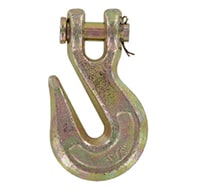
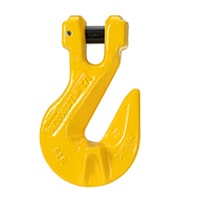
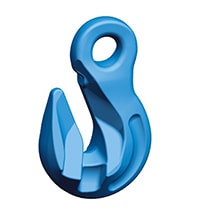
Hooks Designed for Anchor Snubbers - Method #2
Manufacturer:
Suncor Stainless
Product Name/Number:
Snubber Hook / S0191-0007, 008, 010
Link to Product Page:
Sizes (in/mm*):
1/4", 5/16", 3/8" chain
Material/Process:
316 Stainless Steel / Cast
Notes:
Well made cast stainless steel hook from a well known US marine hardware manufacturer. The design is similar to one of the early Mantus designs. Not load rated but they get bonus points given their reputation for quality.
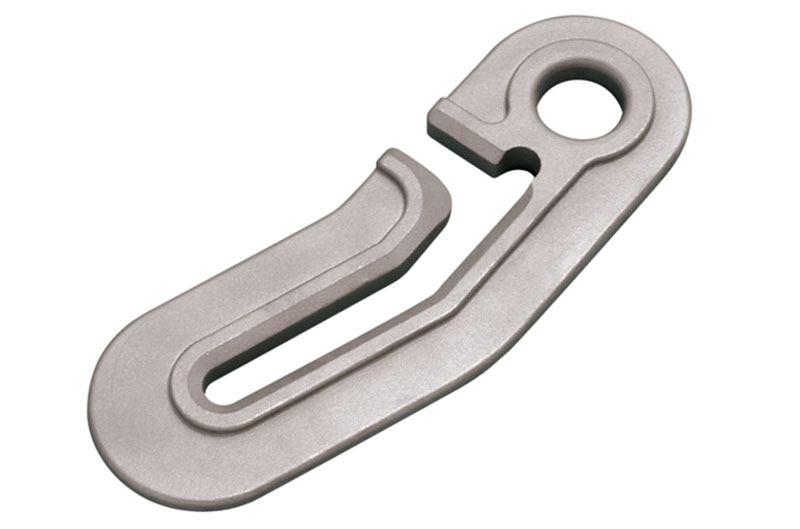
Manufacturer:
CS Johnson
Product Name/Number:
Captain Hook / 46-465-5, 46-475-5
Link to Product Page:
Sizes (in/mm*):
Small - 1/4" & 5/16" chain, Large - 3/8" & 1/2" chain
Material/Process:
316 Stainless Steel / Not Provided
Notes:
Easy to attach and shouldn't hang up in the bow roller. There are a couple of reviews from folks claiming the prongs on the larger hook splayed out in heavy weather, making the hook ill-fitting and unreliable. Not load rated. There are Chinese copies of this hook out there but I have no knowledge of their capacity or performance.
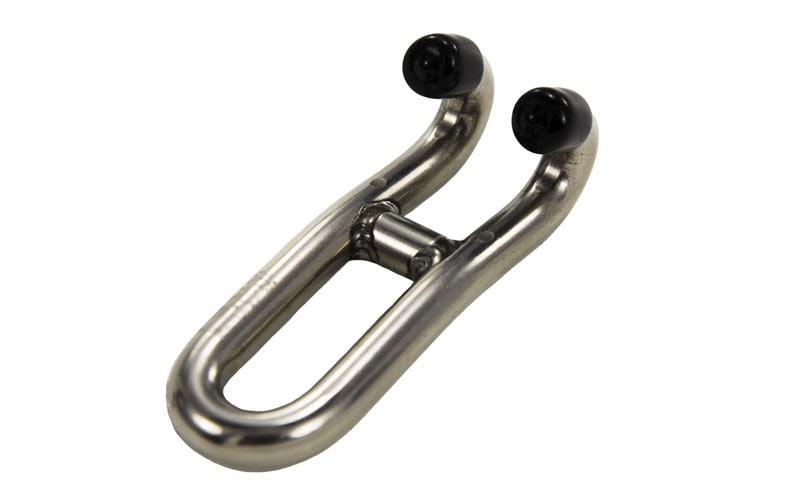
Manufacturer:
Seadog
Product Name/Number:
Chain Gripper Plate / 321850
Link to Product Page:
Sizes (in/mm*):
5/16", 3/8", 7/16", 1/2" chain
Material/Process:
316 Stainless Steel / Investment Cast
Notes:
For bridles with two independent legs only (great for strength and redundancy) but is spec'd with two large forged bow shackles (Seadog part #147212) making the overall product expensive. Most homemade hooks I've seen are variations of this plate-type design. Not load rated.
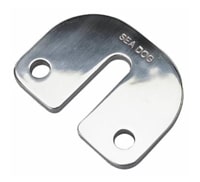
Manufacturer:
Victory Products, Osculati & Various Chinese Companies
Product Name/Number:
Victory Hook / CH2303, CH2304, Osculati 01.744.06, 01.744.10
Link to Product Page:
Sizes (in/mm*):
Small - 1/4"-5/16", Large-3/8"/10-12mm (does not fit US 1/2") chain
Material/Process:
316 Stainless Steel / Cast
Notes:
Giant eye provides flexibility: it can be used for a snubber with the hard eye made directly on the hook or a hard eye
with shackle. It can also be used with a spliced Y bridle or 2 independent-legged bridles.
The large hook can be a little cantankerous to get on/off with 3/8" chain, but it cradles the link well.
The larger hook does not clear some bow rollers. Various Chinese companies have started making this hook
and most support US 1/2" chains where the original Victory hook does not. The Chinese versions I've seen have a dull, heavily
pocked surface and a rough finish. Regardless of the manufacturer, these hooks are not load rated.
Update 1/19/2023: A reader (thanks Steve!) notified me
that Osculati did test their hook and the result can be found
here.
Their hook showed moderate deformity at 13,938 lbs / 62 kN's.
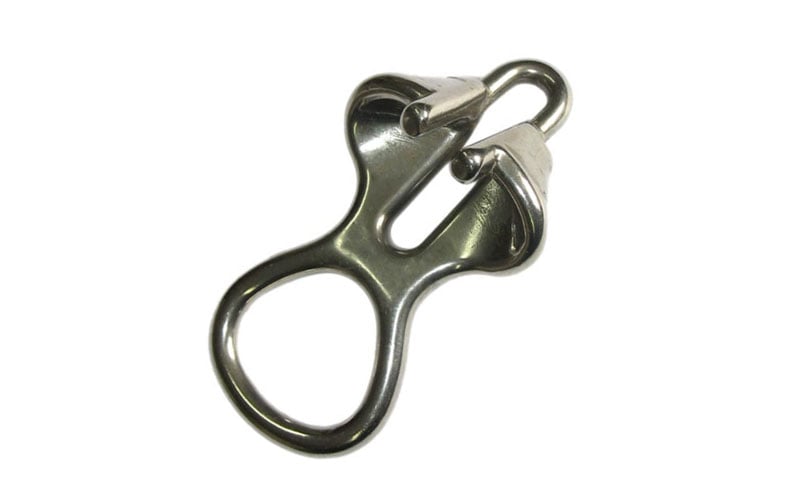
Manufacturer:
Mantus Marine
Product Name/Number:
M2 Chain Hook / M2SSH14A, M2SSH516A, M2SSH38A, M2SSH12A
Link to Product Page:
Sizes (in/mm*):
1/4", 5/16", 3/8", 1/2" chain
Material/Process:
2205 Duplex Stainless Steel / Not Provided
Notes:
Usual thoughtful design, high-quality and high strength product you'd expect from the folks at Mantus. Cradles chain link to preserve chain strength and comes with a heavy duty shackle and a keeper strap to ensure the hook stays attached. Straps will likely need to be replaced periodically and are ~$2 - $5 depending on size. Product is load rated and WLL is similar to the WLL of the hook's respective chain size.
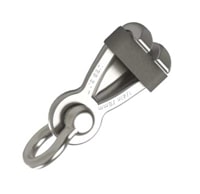
Manufacturer:
Wichard Marine
Product Name/Number:
Chain Grip / #2994, #2995, #2996
Link to Product Page:
Sizes (in/mm*):
Small - 8mm (5/16"), Medium - 10mm (3/8"), Large 12mm (1/2")
Material/Process:
2205 Duplex Stainless Steel / Not Provided
Notes:
This beautifully finished, small and compact hook is load-rated. It's our third best-selling hook. Wichard redesigned it to eliminate the keeper pin, which was known to bend occasionally and to fully accommodate US/Imperial chain sizes. The product is load-rated, but the standard used for testing could not be determined (appears to be ATSM Int'l).
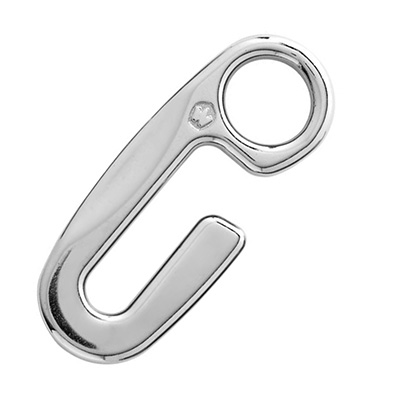
Manufacturer:
Kong
Product Name/Number:
Chain Gripper
Link to Product Page:
Sizes (in/mm*):
Small - 5mm-8mm (1/4"-5/16"), Large 8mm-13mm (5/16"-1/2")
Material/Process:
316 Stainless Steel / Not Provided
Notes:
Another small and compact hook with a slot for the link and a captive pin to secure the link in the slot. I've sold a few dozen of these but haven't spoken with customers using them so I can't speak to their performance. The hook is load rated (testing standard is unknown) but Kong is a reputable manufacturer and widely known for rock climbing and spelunking products. Made for metric sized chains so use care when purchasing for US/Imperial chains.
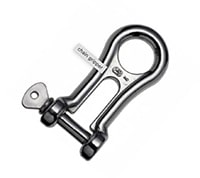
Manufacturer:
Ultra Marine West
Product Name/Number:
Ultra Chain Grab
Link to Product Page:
Sizes (in/mm*):
5mm-12mm (could not find good source for US/Imperial equivalents / chain types)
Material/Process:
316 Stainless Steel / Not Provided
Notes:
High-quality hook that fits chain sizes to 3/4” (18mm). It can be removed from loaded chain and claims to roll through the bow roller without incident. Load rated but expensive. Update 4/20/2023, despite being told by manufacturer's rep in 2022 the company was discontinuing these hooks, they appear to continue to stock them.
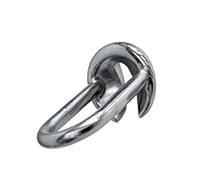
Shackles - Method #3
One method we're hearing more about is the use of Dyneema in various configurations in lieu of hooks. Soft shackles seem to be the most common but there are also simple loops with stopper knots where you thread the loop through the chain link and then attach it to a shackle. Dyneema should be ideal in this application because of it's high strength and resistance to abrasion, not to mention it's inexpensive (at least in the quantity needed for this application) and lightweight. 49° North Marine is currently testing a soft shackle for use as a snubber and we hope to have it available in spring 2023.
Certainly not a common method, but some folks prefer to use a steel shackle with a captive pin that runs
through the chain link. The key words here are "captive pin". Simplicity has it's advantages but I would need to
carry spare shackles as they would eventually find their way overboard. If using a shackle, it might be worth getting one
with the largest oversize pin that would go through the chain link and having a multi-purpose deck or shackle tool
handy to tighten the pin.
[Images below: Dyneema soft shackle w/ anti-chafing, Suncor anchor shackle]
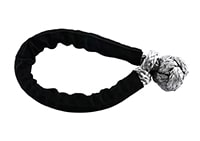
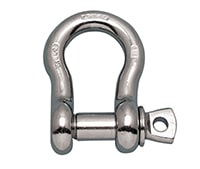
Old Fashioned Knots & Hitches - Method #4
A good solution is often the simpliest one. A case in point is the knot or hitch - simple, inexpensive and relatively secure. No thimbles, shackles or splices. A well-tied knot is probably the least likely to fall off the rode when compared to a steel hook and they have little or no impact on chain strength. As with all things, knots are not perfect. While most are secure, some are difficult to tie, some can slip and others are difficult to untie, especially when wet and previously loaded. Additionally, knots can weaken the rope by 50% or more. A few common knots:
Rolling Hitch - Many of the old salts swear by this hitch and it's probably the most popular of the knots used for snubbing an anchor. It's easy to tie and unlikely to fall off but can slip in stong winds. The rolling hitch can be tied comfortably on deck and veered over the anchor roller but can be difficult to untie after being wet and loaded.
Icicle Hitch - The icicle hitch can be difficult to tie at first but it holds well under loads. It can be difficult to remove after being loaded and wet.
Prussik Knot - The Prussik knot requires a sling of rope or pendant which is then looped around the rode and passed back through itself one or more times. Once made, the remaining bit of loop is secured to the hard eye of the snubber with a shackle. The Prussik is easy to tie and remove, is secure and can be veered over the anchor roller if some tension is maintained. Be sure the working load limit of the loop exceeds your overall load requirements. If you're making the loop yourself, splice the ends together or use a low impact knot like the double fisherman's bend and consider the impact of each on overall strength.
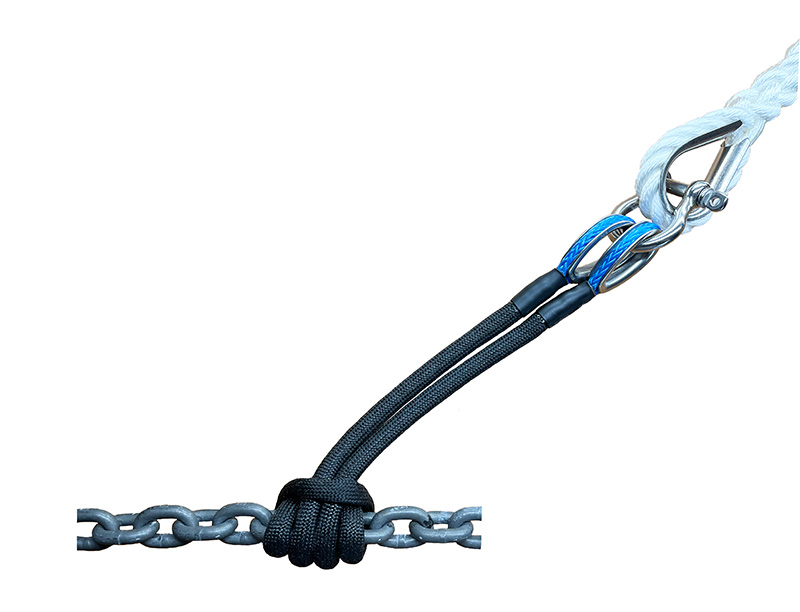
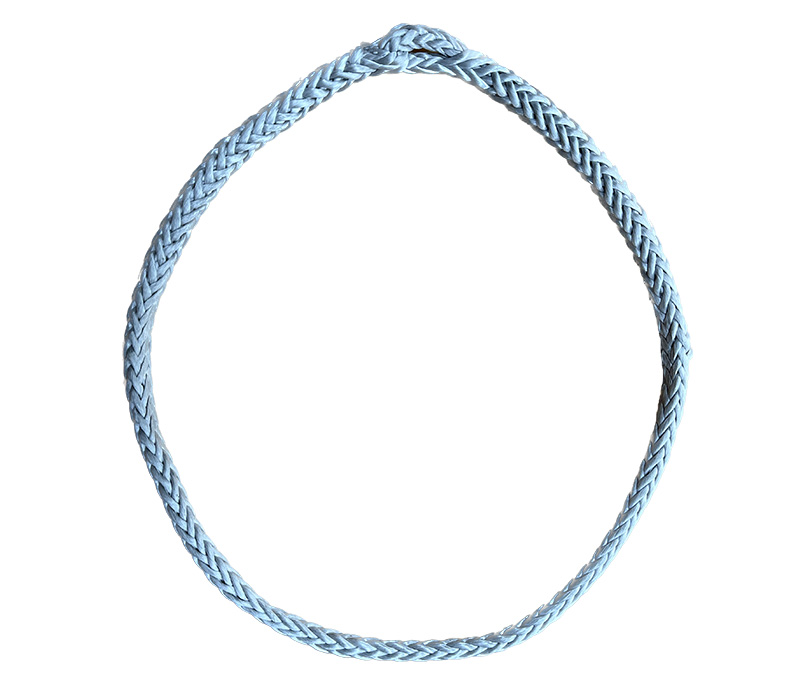
[Images: 49° North Marine Dyneema® Snubber Pendant & Snubber Sling]
Final Considerations for Snubber Hooks
Once you understand the load your boat will create on the snubber or bridle, size the rope, shackles and hook appropriately. Use the working load limit of the various components and not their tensile or break strength. Spend time researching the right size for the line (see our Snubber Size Calculator page) as right-sizing the line is important to get the desired benefit; over and under-sizing lines can be detrimental. Consider over-sizing the hardware (not the lines) slightly to build in a safety factor. Buy forged components where possible and use heavy-duty thimbles for boats that are considered heavy for their respective size. Heavy duty thimbles are significantly more expensive in the larger rope sizes but they will retain their shape and preserve rope strength. Since many of the popular snubber hooks are not load rated, the hook often is the wildcard component in the system, which is somewhat discomforting. Luckily, we rarely hear or read about hook failures. Frankly, I'm more concerned about one falling off than failing.
*Metric equivalents are included where published by the manufacturer. I did not perform conversions.
Doug Neil
49° North Marine
Publish Date: 11/17/2020
Last Update: 4/19/2024
I do NOT derive income from affialite links or commissions on these products
